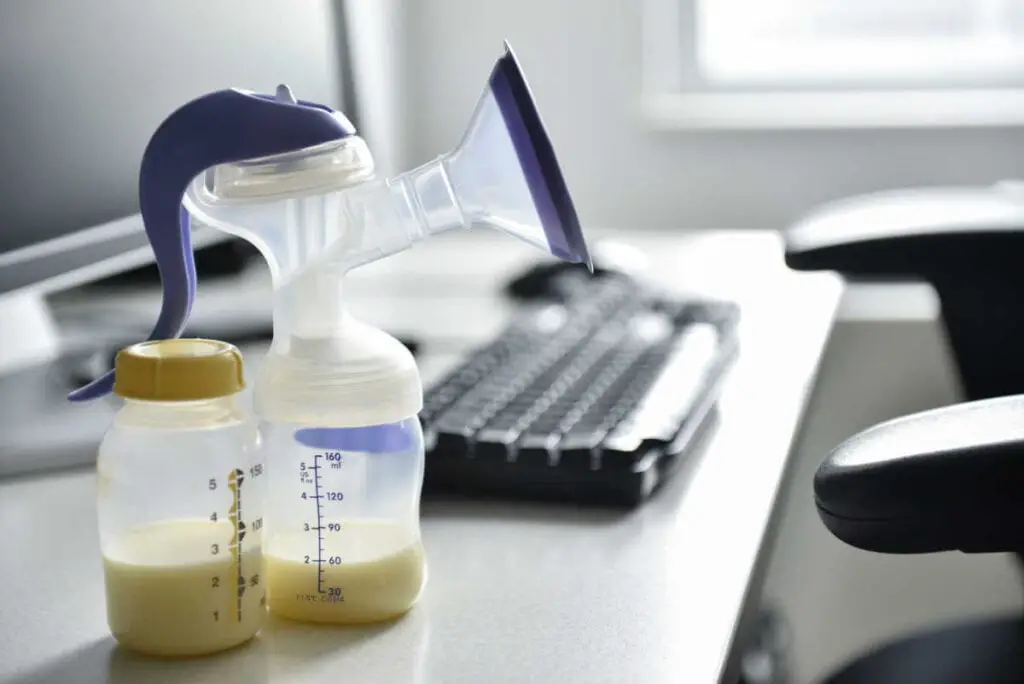By Jake Marcus, JD
According to the US Department of Labor, 56 percent of women with children under age three are employed outside the home in the civilian workforce.1 In order for these children to be fed breastmilk, most of their mothers will need the cooperation of their employers. And for that cooperation to happen, significant amounts of educating and planning are necessary. But many women who plan to breastfeed are unsure of how they will continue to do so when they return to work. Some mothers wean their children before returning to their jobs, assuming that they won’t be able to coordinate lactation and out-of-house employment. Women planning to pump their breast milk at work may be surprised by an employer’s reluctance or unwillingness to make the necessary changes in their work arrangements. Similarly, many employers are unaware of the needs of lactating mothers who are their employees, and of the benefits to employees and employers alike of creating an environment conducive to workplace pumping.
Few employers have support programs in place for workplace lactation, and few laws protect lactating employees. While plenty of research is readily available that documents the benefits to employees and employers of lactation-friendly work environments, ignorance among employers and a lack of legal protection puts the burden on the employee to create a plan that clearly identifies, explains, and justifies her needs. But experts agree that, when equipped with knowledge of their legal rights, a well-formulated plan, information, and dedication, most women employed outside the home can continue to feed their children breast milk.
Do US Employers Provide Breastfeeding Support?

Only 26 percent of US employers report having had a “lactation program/designated area” for their employees in 2007.2 However, these employers do not specify whether this means there is a private room in which to pump on-site, professional lactation support, subsidies for breast-pump purchases, or whether the “lactation program” consists of no more than allowing employees to pump in their own offices. The larger the employer, the more likely it is to have a lactation program and/or designated area. Forty-two percent of organizations with 500 or more employees report having a “lactation program/designated area,” while only 9 percent of businesses with fewer than 100 employees do.3 The rate of lactation programs also varies by industry, though the results are a bit surprising. In the private service industry—which includes such jobs as hotel maids and waitresses, who are unlikely to have long break times or private offices—the rate is 25 percent, which is pretty much the same rate as that for all employers.4 For government employers, however, the rate is only 11 percent5—which is positively dismal, especially in a country with federal and state policies that support increasing the rate of breastfeeding.
The good news is that the number of employers reporting having lactation programs and/or areas has been rising—to 26 percent in 2007, up from 18 percent in 2003.6 The bad news remains that only a quarter of US employers appear to have lactation support in place for their employees.
Isn’t There a Law?

No federal law establishes or protects a right to pump breast milk in the workplace. [See Federal Law page on this site for an update concerning the impact of the Affordable Care Act.] Although 15 states have statutes concerning the practice, these laws vary widely in what they require employers to do to accommodate employees who express breast milk, and some don’t require employers to do anything at all.7 As of this writing, the laws of California, Connecticut, Hawaii, Illinois, Minnesota, Mississippi, Montana,8 New Mexico, New York, Oregon, Rhode Island, and Tennessee state that an employer “shall” or “must” allow pumping during breaks and/or provide a place to pump, while Georgia and Oklahoma state only that employers “may” allow breastfeeding employees to pump while at work. But if a state law uses “may” language, the employer is under no obligation to allow workers to pump or to provide any workplace supports. Among those laws that do require employers to allow workers to pump, some, like Mississippi’s, provides only that an employer cannot forbid pumping during meal or break times that the employee already gets, not that the employer provides a designated pumping space9 (with the exception, in Mississippi, of child-care-facility employees10). New Mexico law, however, requires not only that the employer provide a woman a space to use a breast pump, but also that space be “clean and private… near the employee’s workspace… and not a bathroom.”11
No current state law relating to workplace pumping requires that an employer give an employee break time in addition to the time to which she is already entitled. Only three state workplace statutes—those of California,12 Hawaii,13 and Oregon14—provide for penalties against employers who violate a worker’s right to pump.
A state law that does not require employer compliance can nevertheless serve as a guideline for employers who are willing to help lactating employees, particularly when the law includes specific descriptions of what a pumping woman might need. Under Oklahoma’s workplace pumping law, while the employer is not required to allow pumping or to provide a space in which to pump, the statute states that any space that is provided should not be a toilet stall, should be private, and should be close to the employee’s work area.15 While this kind of law creates no rights for the employee or obligations for the employer, it does establish, for both, a model of a family-friendly workplace, as well as the state’s support of those employers who create such an environment.
Why an Employer Might Object to Workplace Pumping

Cate Colburn-Smith, co-author (with Andrea Serrette) of The Milk Memos: How Real Moms Learned to Mix Business with Babies—and How You Can, Too, identifies perceived low demand as one of the major reasons employers resist supporting lactation in the workplace.16 Employers believe that few women want or need to pump at work because too few women ask for the changes they need. Educate your employer about the number of workers who will or might use the resources you are requesting.
The “fairness doctrine”—the mistaken notion that supporting workplace lactation with such policies as longer break times or a special space in which to pump is somehow unfair to non-lactating employees—is another reason an employer might resist making changes, according to Colburn-Smith. Heather Chase, MS, RN, IBCLC, RLC, president of Corporate Lactation Services, Inc., agrees but says that, in reality, complaints from other employees about lactation-support benefits are rare.17 Make sure your employer knows that meeting your needs will not disrupt the workplace or interfere with other workers, and be prepared to help your employer educate coworkers about the benefits of breastfeeding.
Employers, particularly smaller ones, may worry that providing lactation-support benefits may be too expensive. However, studies of existing workplace programs show that such programs actually save employers money in decreased absenteeism and increased productivity.18 Jane Johnston Balkam, PhD, APRN, CPNP, IBCLC, owner of Babies’N’Business, LLC, a company specializing in workplace lactation support, suggests looking for an existing physical space that can be “captured” to use as a pumping room. She notes that, particularly in older buildings, often space already exists and will require little money from the employer to convert.19 Potential financial costs may also be outweighed by public-relations benefits, particularly in states that have legal definitions of mother-friendly and/or family-friendly for which the employer might apply and receive free publicity.20
Talking to the Boss

Chase and Colburn-Smith agree that the best time to approach your employer about your breastfeeding needs is while you’re pregnant. Don’t wait until after you’ve had your baby to think about pumping at work—as a new mom, you’ll have more than enough to do. However, it’s never too late to create and present a written plan to your employer. Most changes in business operations result from executive adoption of a written plan that has been developed by an employee or team of employees. By providing a written plan, you show that you have invested serious thought and research in your proposal and that you have adopted a business perspective on the problem.
Look for allies. Find out which of your coworkers might be pregnant or have a nursing child at about the same time you will. Find the moms who might already be pumping, but under conditions that you all have an interest in changing—or those who, in years past, may have pumped while hiding in a bathroom stall.
Deliver your plan in writing. Chase points out that e-mail may be perceived as less confrontational, and can sidestep the possibility of your supervisor feeling uncomfortable about talking with you directly about your breasts. Chances are that if your employer now provides no support for pumping on the work-site, you will be the first person to approach him or her. You should assume that your employer is unaware of the issue, but not that he or she is opposed to pumping in the workplace.
Make sure you bring your proposal to the person in the best position to help you. In a larger company, there may be an entire department dedicated to “work/life balance” that is responsible for family leave, flexible work schedules, on-site daycare, and all employee benefits associated with being “family-friendly.” Nearly all employers of medium to large size will at least have a human resources department. Gain this department’s (and your employer’s) support by showing that you’ve already thought through many of the issues and have developed practical solutions for them. These may be the people who will approve your plan, or who will recommend its approval to management.
Somewhere, among your allies and the administrators in charge of making the decision, you may find that person whom Jane Balkam identifies as being “key” to creating critical change in company practice regarding breastfeeding—in short, your “champion.” Until you start, you may not know who in the organization might already support breastfeeding, or who will strongly fight for a support program once he or she is informed about it.
Making a Plan

As early as possible (preferably while you’re still pregnant) figure out what you’ll need to meet your pumping needs while at work. Even experts in workplace lactation-support programs share no standard definition of what such a program should provide.21 Few employers will provide a worker with everything she requests, and what any individual worker will need may vary widely based on her work, the environment in which she works, and the nursing/pumping relationship she has with her baby and her body.
Next, assess which of these things are already available to you in your current work arrangement. Check with your health insurance carrier to see whether and to what extent consultations with lactation consultants are covered. (Some policies also cover all or part of the cost of a hospital-grade breast pump.) You may already have your own office with a lock on the door, but the constant interruptions of phone calls and e-mail could make a separate room a better option for pumping. Consider the spaces convenient to your work area, and how they might be used as lactation rooms some or all of the time. When drafting the plan for your employer, assume that your existing lunch and break times are available to you as times in which you may pump. Know whether your state has a law that can be helpful to you if your employer forbids you to pump, but until that happens, always communicate to your boss with confidence that whether you will pump at work is not a question.
Then, identify the things you want to add. Start with more than you expect to get, and anticipate giving up on some of what you propose. Don’t consider access to a lactation consultant a luxury. A board-certified lactation consultant can be critical to the success of a workplace program. In a recent study of one government-agency program, the “return-to-work consultation” with an IBCLC seemed to have the greatest impact on the length of time women continued to breastfeed.22 Heather Chase says that, without proper breastfeeding support, “you can have a room, you can have a pump, and they’re collecting dust.” Some aspects of potential lactation-support programs may be less important than they first appear. Many employees begin with a request for a written workplace policy supporting breastfeeding and prohibiting discrimination on the basis of it. However, employers who have not been educated about the ease with which pumping can be incorporated into the work environment, and who have baseless fears of legal liability, may resist agreeing to a formal policy. It may be more important to get the structural changes required to support workplace pumpings, such as break time and a lactation room, and wait, as Jane Balkam suggests until the program’s success makes a written policy less threatening to the employer.23
Many resources are available on the Internet that a worker can use in drafting a written proposal that will educate her employer about the benefits to children of breast milk, and of the benefits to the employer of providing lactation support to employees. A good place to start is a United States Breastfeeding Committee report, “Workplace Breastfeeding Support.”24 In addition to describing the results of many studies on the benefits of breast milk to children and breastfeeding to women, this report also outlines the benefits to the employer of providing workplace support for lactating women. Key among these benefits are a “cost savings of $3 per $1 invested in breastfeeding support,” “reduced absenteeism to care for ill children,” “lower health care costs (an average of $400 per baby over the first year),” and “improved employee productivity.” A pamphlet from the International Lactation Consultants Association reports on the connection between breastfeeding and a reduction in the common childhood illnesses that keep employees home and cost employers money.25 From a single chart in this pamphlet, employers can learn that ear infection, which keeps mothers home from work for one to two days each year, can be reduced by two-thirds to three-fourths; and that respiratory infections, which also increase employee absenteeism by one to two days annually, can be reduced by three-fourths—all from feeding a child breast milk.26 Also available to show your employer are the lactation-support programs currently in place at several key government agencies. The US government’s Centers for Disease Control and Prevention (CDC) Healthier Worksite Initiative includes a lactation-support program under which all CDC employees receive benefits, including a prenatal breastfeeding class; unlimited telephone counseling with a board-certified lactation consultant; and “lactation rooms” equipped with a hospital-grade breast pump, lockable doors, and refrigerators.27 The website of the Healthier Worksite Initiative lactation-support program also contains a detailed “toolkit” with information and photographs of every aspect of the program, including different lactation rooms, program policies, and program implementation and evaluation.28 Another helpful resource is The CDC Guide to Breastfeeding Interventions, which has a chapter on “Support for Breastfeeding in the Workplace.”29
Also publicly available are a list and brief descriptions of the services provided for employees at the National Institutes of Health, including prenatal breastfeeding classes, lactation rooms, and support from board-certified lactation consultants (including a “back to work consultation”).30 Another comprehensive lactation support program whose description is available on the Internet is that of the US Department of Health and Human Services Indian Health Service, which includes separate “Frequently Asked Questions” circulars for employees, supervisors, and managers.31
Support for workplace lactation can be found in the business community itself. The National Business Group on Health (NBGH), a health-care policy group consisting entirely of large employers, describes breastfeeding as “offer[ing] important economic benefits to families, employers, and society at large.”32 In characterizing the failure to breastfeed as a “workplace burden,” the NBGB also writes that “[c]hildren who are not breastfed contribute to huge additional healthcare expenditures for the employers of their parents. Their parents are also responsible for significant productivity losses in the workplace associated with absenteeism and presenteeism.”33 Another excellent evidence-based resource to share with your employer is “Breastfeeding Support at the Workplace: Best Practices to Promote Health and Productivity,” a report by the Washington Business Group on Health on existing corporate lactation support programs.34 In addition to offering a review of the tangible benefits to the employer, the report includes a review of successful lactation support programs in place at such major corporations as Procter & Gamble, Cigna Corporation, Home Depot, and AETNA. No proposal to an employer would be complete without including endorsements produced by the business community itself. Finding community Pumping in the workplace can be lonely. Not only can finding other moms in the same position help you get what you need from your boss, but it can also help you get through the tough times. The book The Milk Memos began as a notebook in which moms who took turns using a former closet to pump during working hours to breastfeed their infants shared their experiences and offered each other advice.35 On the message boards of www.workandpump.com, moms discuss such issues as which hotels are most pumping-friendly for business trips, and tips for cleaning pump parts.
You Can’t Always Get What You Want, But if You Try Sometimes You Can Get What You Need
There is no better time than now to advocate in the US for workplace lactation support. Despite the lack of legal protections, an abundance of resources is available to workers and employers that will assist them in creating workplace programs that provide valuable benefits to all.
NOTES
1. US Department of Labor, Bureau of Labor Statistics, Women in the Labor Force: A Databook, Table 5 (2007): www.bls.gov/cps/wlf-databook2007.htm.
2. Society for Human Resource Management, 2007 Benefits: A Survey Report, Table A-1 (Alexandria, VA: 2007): 8.
3. Ibid., Table A-2: 10.
4. Ibid., Table A-3: 11-12.
5. Ibid.
6. Ibid., Table A-4: 13.
7. See the state law pages of this website (BreastfeedingLaw.com) for US breastfeeding legislation.
8. Montana’s workplace pumping law applies only to state and government employers, including public school districts and the state university system.
9. Mississippi Code Section 71-1-55 (2006).
10. Mississippi Department of Health, Office of Health Protection, Child Care Facilities Licensure, Regulations Governing Licensure of Child Care Facilities, Section 117.07 (2006).
11. New Mexico Statutes Annotated Section 28-20-2 (2007).
12. California Labor Code Section 1033 (2001) (enforcement by Commissioner of the California Department of Labor).
13. Hawaii Revised Statutes Section 378-5 (1999) (complaints filed with the Hawaii Civil Rights Commission, or employee can file a private lawsuit).
14. Oregon Revised Statutes Section 653.256 (2007) (Commissioner of Bureau of Labor and Industries may assess civil penalty).
15. 40 Oklahoma Statutes Section 435 (2006).
16. This and subsequent references: Personal communication (17 October 2007).
17. This and subsequent references: Personal communication (12 October 2007).
18. Workplace Breastfeeding Support, United States Breastfeeding Committee (2002):www.usbreastfeeding.org/LinkClick.aspx?link=Publications%2fWorkplace-2002-USBC.
19. This and subsequent references: Personal communication (25 October 2007).
20. See, e.g., Texas,www.dshs.state.tx.us/wichd/lactate/mother.shtm#item2.
21. Jane Johnston Balkam, A Workplace Lactation Program: Evaluation and Impact, unpublished doctoral dissertation (2006).
22. Ibid.
23. See Note 19.
24. See Note 18.
25. Doraine Bailey, MA, “Breastfeeding: The Best Investment…” (Raleigh, NC: International Lactation Consultant Association, 1998.
26. Ibid.: 3.
27. Centers for Disease Control, Atlanta Human Resources Center, Healthier Worksite Initiative, “Lactation Support Program,” Human Resources Policy CDC-790-1 (8 August 2005): www.cdc.gov/nccdphp/dnpa/hwi/policies/Lactation Support Program.pdf.
28. Centers for Disease Control, Atlanta Human Resources Center, Healthier Worksite Initiative, “Lactation Support Program” (22 May 2007).
29. K. R. Shealy et al., The CDC Guide to Breastfeeding Interventions (Atlanta, GA: US Department of Health and Human Services, Centers for Disease Control and Prevention, 2005): 7; http://www.cdc.gov/nccdphp/dnpao/hwi/toolkits/lactation/index.htm.
30. IHS, Lactation Support Policy in the Workplace, http://www.ors.od.nih.gov/sr/dohs/Resources/nursing/Pages/lactation.aspx.
31. http://www.ihs.gov/MedicalPrograms/MCH/M/bf.cfm
32. K. P. Campbell and S. Chattopadhyay, “Breastfeeding Evidence-Statement: Counseling,” in: K. P. Campbell, S. Chattopadhyay et al., eds., A Purchaser’s Guide to Clinical Preventive Services: Moving Science into Coverage (Washington, DC: National Business Group on Health, 2006): 24; www.businessgrouphealth.org/benefitstopics/topics/purchasers/condition_specific/overviewpregnancychapter.pdf.
33. Ibid. 34. Rowena Bonoan, MPH, “Breastfeeding Support at the Workplace: Best Practices to Promote Health and Productivity,” Washington Business Group on Health 2 (March 2000): www.businessgrouphealth.org/pdfs/wbgh_breastfeeding_brief.pdf.
35. Cate Colburn-Smith and Andrea Serrette, The Milk Memos: How Real Moms Learned to Mix Business with Babies—and How You Can Too (New York: Tarcher/Penguin Books, 2007), 17-19.
This article was first published in Mothering magazine, (May/June 2008). This version is has been updated by Jake Marcus since the original publication. (c) Jake Marcus. When in doubt go to the individual state page on this site for the current wording of state and federal law.
This article is dedicated to the late Chris Mulford, without whose kindness, assistance and wisdom, the piece would have been a poor shadow of itself. She is sorely missed.









